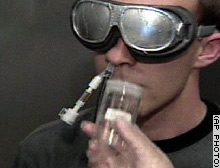
Researchers training the nostril -- and the brain -- to recognize androstenone. CNN's James Hattori looks at how smell research testing the nostrils at UC-Berkeley could help lead to repairing brain or spinal-cord injuries (October 23) BERKELEY, California (CNN) -- What could your nose have to do with treating a brain injury? Neuroscientists at the University of California, Berkeley, believe that a person's brain can be trained to make his nose detect new smells. They say the implication is that the brain also could be trained to recover from injuries. These findings are detailed in a study published in this week's issue of the journal Nature. Just like 30 percent of the population, the 12 people who participated in the study were unable to detect an odor from the steroid androstenone -- which people sensitive to the chemical call foul. The researchers, led by graduate student Joel Mainland and assistant professor of psychology Noam Sobel, exposed the participants to androstenone every day. The trick is that only one nostril was exposed during the experiment -- the other was completely blocked. After 21 days, both nostrils could detect androstenone. What makes that result surprising is that there is no neural link between the nostrils at the peripheral level -- so researchers concluded that the shared learning occurred in olfactory structures in the brain. "The fact that a nostril (that) never saw this odor learned how to detect it suggests to us there must have been some sort of change in the brain," said Sobel. This leads researchers to surmise that the brain is more plastic, or capable of change, than previously thought. If the brain can train itself to learn new aromas, perhaps it can be trained to overcome, for example, paralysis or other nervous system damage. "It's widely appreciated that the last 10 years have sort of been a revolution in how much we know about how the brain functions," Sobel said. More research is already planned. The team will next examine the differences between people who can learn to detect a smell through exposure and those who cannot. They'll also use magnetic resonance imaging to see where in the brain this learning is occurring.